C.E. Flores's Blog, page 55
July 30, 2018
Becoming an Herbalist Free Course
Herbal Academy has done it again! Another incredible course and an incredible price (honestly, you can’t get a better price than free) focusing on the question “What does an herbalist DO? “
Lesson 1 looks closely at certification and regulation for herbalists and explores some of the educational options that are available to those interested in herbal careers. L
In Lesson 2, we will take a look at the language that herbalists use – words you can and cannot use legally, regardless of education, due to the current state of herbalism as an unlicensed practice.
Lesson 3 dives deep into the ethical considerations of becoming an herbalist.
In Lesson 4, we will outline key aspects of starting your own herbal business and the many details that go along with each.
Lesson 5 discusses the importance of keeping your finger on the pulse of herbalism. 
Class begins on August 6, so don’t wait too long!
********
[image error]
July 28, 2018
Last call–Parenting Super Bundle
Did you get yours? The Parenting Super Bundle expires July 31.
Here are just a few of the fabulous items you’ll find in this bundle:
Don’t wait! This bundle is only available until July 31. Find out more here.
**************
[image error]
July 26, 2018
Where’s the beef?
[image error]
If your town has a large grocery store, you can buy your meat in the meat section there, however, it will likely be fairly old meat. For the freshest cuts, buy your meat before 11 am at the carnicería.
[image error]Butcher establishments are often marked with a red flag rather than a sign.
[image error]
If the carnicería does boast some signage, you can be sure both a pig and cow will be predominately featured just so there’s no mistaking what meat items can be found there.
[image error]
Any and all pig or cow bits can be bought at the carnicería. Typically the animal is butchered at el rastro that morning and brought by meat delivery trucks. Our area is serviced by el rastro out by the sewage treatment plant. You can take your own pig or cow there to be butchered and come back with the entire pieced animal in buckets in the back of your truck. The Mexican government provides a guidebook for butchering meat at el rastro here.


Meat at the carnicería is bought by the kilo or by a specific price. You can ask to have it cut to a specific size. When my husband buys meat he tells the butcher what he wants to cook and he’ll get what he wants. For example, “$200 pesos de carne para menudo” and the butcher will give him pata, bufi, and panza, the meat ingredients for menudo.
[image error]
Just like moo-cows, piggies came along with the Spanish conquistadores and were embraced by the indigenous Mexicans with open arms (or rather open mouths). Pozole, once reserved for the priests and elite, now became the dish of the common man since pork could replace the human meat used to make this delicacy. Apparently, they taste about the same.
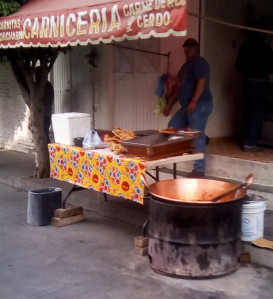
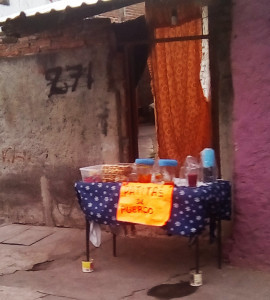
These days, you can often find a bubbling vat of carnitas at every street corner and a line of hungry pork devotees lined up halfway down the block. Carnitas are a bit greasy for me first thing in the morning, but I can’t deny their popularity. Should you wish to eat a little pork, here’s a chart to help you get what you actually want when buying at the carnicería.
[image error]
July 23, 2018
Rainy Season Projects
With the rainy season upon us, some of our proposed construction projects have to be put on hold.
[image error]
On the other hand, my sister-in-law has started construction on her house across the street from us in La Yacata because building in the rainy season means you don’t have to buy any water for the cement mix. My husband, son, father-in-law and one of my brothers-in-law are working like a machine to get the foundation done. My sister-in-law is also out there every day after the tortillas have sold to bring nourishment and help out.



That’s not to say all construction on our house has ceased. Our little projects this month included the installation of a small window in the spare room and the front porch screen door.


The front of the animal side of our property was also patched with cement and the roof bit angled ready for tejas (roofing tiles).


I also found what I think might have been part of a gun cabinet at a junk store and lo and behold it’s just the thing for some kitchen shelves.
[image error]
Next month’s projects may or may not include a banana tree, so stay tuned!
July 19, 2018
Rainy Season Electric Woes
The rainy season has arrived in full force and with it some issues with the little house in Sunflower Valley.
The roof that was repaired last year has started to leak again. This meant rearranging the furniture and strategic bucket placement. The roof cannot be refixed until the rainy season is over.
The rain has also caused some electricity issues. The other day, a thunderous rainstorm blew the wire that goes from the house to the post lose. Of course, it was in the middle of an online class. No one else in the neighborhood was affected. We went outside to check it out and saw sparks shooting from the wires.
[image error]
Look at this mess! Is there any wonder there are problems?
CFE came out but said there wasn’t anything wrong. Of course, it was raining when they came out and the World Cup games were on, so I expect they didn’t take much time to look it over. The next day, we headed to CFE to request maintenance. They said they’d be right out, in somewhere between 2 and 5 hours right out that is.
[image error]
While we waited, my husband checked the other wires. The rain had drenched the wires in the box and shorted out the meter as well. Plus, all the wires to the house meet in a clump under the bougainvillea bush and were wet too. He did what he could to fix those but it really is only a temporary fix. A permanent solution would require rewiring the entire house. Not gonna happen.
[image error]
We did eventually get electricity again only to have to go out the next day when a transformer blew. Again, I was in class.
[image error]
Enough was enough. As soon as the power was back, I ordered a UPS (Uninterruptible Power Supply). It isn’t a complete solution since it basically is a battery back-up, but it should help reduce the hours of work I lose because of an electricity outage. Providing the internet is still functioning, that is.
[image error]
*********
[image error]
July 16, 2018
Grocery Shopping in Mexico–a bit of a quest
You can get groceries at a variety of stores. In fact, depending on what you need, you may need to stop at several stores to find all the items on your list.
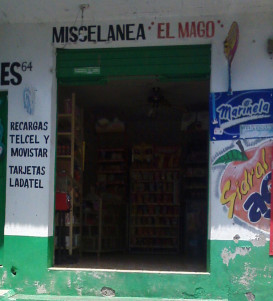
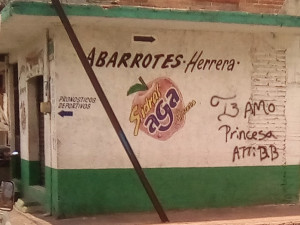
The smallest corner store is usually called abarrotes or tiendita or miscelanea. There’s typically a small selection of necessities including soap, canned goods, and chips. Usually, there’s quite a large selection of chips and soda. Even with the sugar tax, these items remain best sellers and are what probably keep these little stores in business.
If it’s a store you frequent, you may be able to request certain items. For instance, peanut butter is available at some stores but not part of the Mexican diet. If you let the store owner know you’ll be buying it regularly, it just might appear on the shelves.
[image error]
The next size up is the mini-super. There’s a little more selection, but not much.
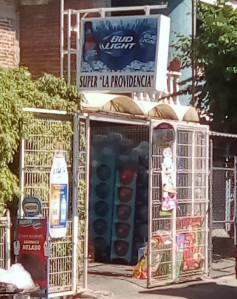
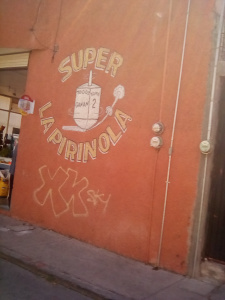
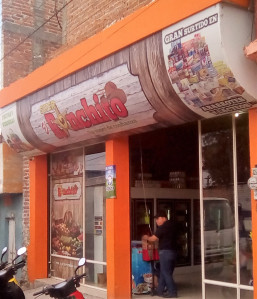
Then there’s the super (from the word supermercado). It has a larger selection and sometimes even a section for imported goods. You never can tell what you might find on the shelves. I once found Mountain Dew at a super. One can cost more than $20 pesos, so I didn’t get it though. Another time I found pesto sauce, but again it was out of my budgeted price range.
[image error]
Mini-supers and supermarkets often have a small section of fruit and vegetables. In a pinch, you could buy your produce there. However, you’ll have more variety of in-season fresh produce at the frutería. You’ll also likely find bags of beans, popcorn, sunflower seeds, cheese cut to order, peanuts, and eggs.
At a frutería you don’t have to buy the whole stalk of celery if you only want 3 stems. You can request that a melon or cabbage be cut into halves or quarters and just buy that. Everything is bought by weight.
Our local frutería houses some cows, goats, and chickens behind the store to aprovechar (take advantage of) the produce that has gone bad. It means, sometimes it’s a bit smelly there and a friend of mine said that she saw a swarm of rats running under the shelves, but what can you do?




Cold cuts can be found in supers or stores that specialize in carnes frias (refrigerated meats) Usually at the back of a super you can find a little deli counter known as a salchichonería (delicatessen). Here you’ll find mostly different brands of processed ham, hot dogs, and bacon. Our local super also carries Vienna sausage which seems a little odd to me, but hey, whatever there is a demand for I guess. It’s possible to buy a packet of hot dogs or ham but all of these items are also sold “suelto” which means you can ask for a specific amount and the deli clerk will slice and dice and package what you want. With the cold cuts, you can request a particular thickness if you like since the standard slice is very, very thin.
[image error]
Often the salchichonería is paired with a cremería (dairy) which includes lacteos (milk products). Here you can buy dairy items like cheeses, butter (although not often available), margarine, yogurt and heavy creams.
[image error]
You can also buy eggs. When you buy eggs, you can ask for a specific amount (10 pesos) or buy by the kilo or media kilo. The eggs will be passed to you in a clear plastic bag, so be careful. You have no idea how many times I’ve broken an egg or two on the motorcycle ride home. If you are buying a large quantity, you can ask the deli person to give them to you in the cardboard egg holders. The cardboard will be layered and tied up and it provides marginally more protection against breakage.
[image error]
You can also do your shopping at the weekly tianguis or at the mercado (market). Vendors have stalls or stands and you can find just about anything. If you don’t see what you want, don’t be afraid to ask.
[image error]
During different growing seasons, you might find temporary stands on the corner or people carrying buckets of different fresh food items. The strawberry and honey sellers are a common sight during certain times of the year. You’ll often see the strawberry sellers carrying plastic buckets and the honey sellers carrying a crate full of their products strapped to their chests.
[image error]
Produce trucks provide fresh fruit and vegetables to outlying areas.
If you live in outlying areas, the produce truck will come to you. You can expect them on set days of the week and stock up until their next pass through.
[image error]
This guy sells elotes (corn) from the back of his truck.
Be on the lookout for trucks with sound systems as well. Jicama, melons, oranges, pineapples and other fresh food can be bought cheaply off the back of these trucks. You’ll find trucks parked at corners or by topes (speed bumps) handing out fresh slices of whatever they are selling on the point of a knife. Feel free to sample before buying. There’s no obligation implied.
[image error]
A wide variety of items can be found at the molino de chiles (literally pepper mill). Not surprisingly, this is your best bet to find ground black pepper which isn’t typically a part of the Mexican diet. Also available are varieties of prepared moles, garlic salt, ground chiles and other seasonings. This is the place to go for baking items like cocoa powder, flour, yeast, sprinkles, candies and if you are very fortunate, chocolate chips.
As you can see, grocery shopping can take the better part of the day at this rate. The trade-off is it’s never the same experience twice. It’s much more like the foraging our ancestors did than modern-day grocery shopping. Where you might have located those elusive chocolate chips last month, may no longer have them in stock, so you must head to another establishment whose owner has different ideas on what the average household needs and stocks his shelves accordingly. Who knows what you might find today?
July 12, 2018
Beefing up Security
If you remember last year after persons unknown hoisted two of our goats and the neighbor’s sheep over the wall, we did some security upgrades. We raised the 6-foot wall to 9 feet and added some motion activated solar lights. As part of our remodeling projects this year, we did some more.
First, we turned our front gate to the animal area into a more or less solid set of doors. My husband used laminas (corrugated roofing) from a neighbor’s discarded chicken house (or at least that’s what the neighbor called it. I’m not convinced his chickens ever considered it a worthy home). As that bit of lamina wasn’t enough to completely cover the door, he bought a few more segments and had the welder come and finish the job.


Our greenhouse had two barred windows put in, preventing front entry to that area. However, we didn’t have enough moolah for the back barred windows which leaves a decided gap that a determined zombie neighbor could pull himself through and get in to wreck havoc with our plants.
[image error]
See that back right corner? That’s the neighbor’s roof. And yes, that’s me, looking like a frog on a log there!
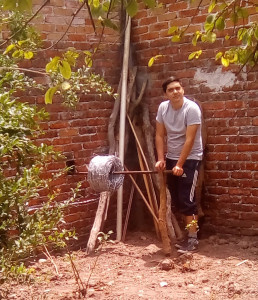
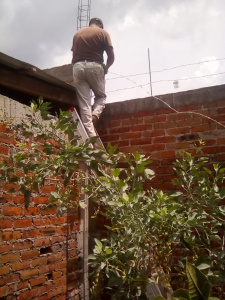
Therefore, a roll of barbed wire was purchased in the meantime and strung from one end of the compound to the other. I’m not positive it will completely deter would-be intruders but it might slow them up a bit until we can afford those back two barred windows.
[image error]
We also took some indoor precautions. I finally went ahead and ordered the carbon dioxide detectors that have been in my virtual shopping cart for a few months. In the news recently, there was a story about a family vacationing in Mexico who died from a leak in the hot water heater. This prompted my actual purchase. Since they came in a pack of three, one went upstairs, one next to my son’s room and the third is on standby or if we need to make the storage room a bedroom again. I know they work because the other day my husband was fiddling with the truck and the exhaust fumes set it off. It’s a horrible high pitch beeping!
[image error]
However, carbon dioxide alarms will not detect a gas leak. So in addition to the CO2 alarms, I ordered a natural gas detector. I’m always the first (and sometimes only) person in the house who smells something funny when there is a leak in our gas tank hose. When my nose says there is an issue, I nag my husband until he checks it with the ol’ soapy water method. I’m usually proven right. Our tank is outside, so the chances if the fumes causing death are low, but gas is expensive these days ($580 per tank) and we don’t have that kind of money to burn. I tested this out too, and it works just dandy.
The security bug hit my husband as well and he went and priced those security camera setups. I’m not sure we need to go that far though. Besides, he’d probably stay up all night watching the video feed of the cows grazing down the neighbor’s crops.
**********
[image error]
July 9, 2018
Unbelievable Residents
So things are picking up in La Yacata. I’d like to say that this is a good thing—but it’s not.
The other day a guy came to find out exactly where a lot was that he had bought. I told him that the certificate he had was not the current valid one and that he should get the new one (which is blue instead of cream) from the previous owner. He went back to the previous owner who said that he didn’t have it. When he came back to report, I showed him a receipt for the new certificate in the papers that he had been given. I then realized that he couldn’t read. So I marked the receipt with an orange spot and told him he needed to go back to the previous owner, show him the receipt and get the new certificate. If the previous owner still refused, then he needed to get his money back because the previous owner had plans to resell the lot to someone else, making double the profit and leaving a mess for the new owners. What do you know? The previous owner “found” the blue certificate. Now that all that was in order, the new owner decided that he wasn’t going to register the lot in his name because, you know, there’s a charge of a $100 pesos and all. And I’d saved him way more than that. Whatever.
The next big adventure with certificates began with the neighbors down below. The lady met me on my walk one morning and asked about getting a certificate changed because her sister had bought a house in La Yacata. Curious, I asked which house. Why, Chuchi’s house, of course. Now, Chuchi doesn’t have any houses in La Yacata. When I said that, she said the house on the corner. Oh–well, that house doesn’t belong to Chuchi but to the original owner. She showed me a certificate Chuchi had made. It was white (which means it’s the second round of certificates that Chuchi gave out) dated 2010, when Chuchi wasn’t the president of the association, made out to Chuchi, signed by Chuchi, and property rights ceded to the lady’s sister by Chuchi. I laughed and said this wasn’t a valid certificate. She said Chuchi said it was. I told her I’d take it to Super Prez, but that I really doubted he would legitimize it. I mentioned that if Chuchi were the owner he should have a contract from the original owner saying so, or receipts of payments. She said Chuchi didn’t pay for the lot but received it as payment for his services as “encargado” person in charge. Again, I said that he should have something from the original owner saying that.
[image error]
Chuchi’s house, built with the ill-gotten gains filched from the community and on a lot he has no claim to.
A week or two later, I stopped by Super Prez’s office and saw another certificate made by Chuchi, signed by Chuchi and ceded by Chuchi, only this one was cream (meaning it was from the first batch of certificates) and had a date of 1998. Since the lady down the road hadn’t mentioned this to me, I supposed she dropped it off at the office herself as “proof” that Chuchi was the owner. While I was there, Super Prez called his secretary and I talked to him on the phone. He said he didn’t have any intention of validating that certificate because the property in question still belonged to his dad, furthermore, that lot was our backup plan to pay the lawyer with. We still owe most of the balance on the court case occasioned by Chuchi. Then he said that the person who Chuchi ceded the certificate to was his own wife. Well, since the lady down the road is his sister-in-law, that would make sense even though she presented the situation to me as if it were a different sister living in the US, not the one married to Chuchi.
Now the lady down the road isn’t speaking to me as if any of this is my fault. And this after I explained she needed a power inverter to use the car battery and then sent her along to the guy who sold us the solar setup to get her own. No good deed goes unpunished I suppose.
[image error]
The chicken feather guy’s compound. Chickens, pigs, horses and cows!
Finally, there’s the chicken feather guy who you know is the bane of my existence. He evolved from chickens and pigs to cows and horses (sold for meat). Only as cows and horses eat more, he’s decided that he’d let them out all night to forage instead of buying more feed. Whatever crops were still alive despite the heat wave have now been devoured. Of course, the chicken feather guy puts his cows and horses back in his compound before anyone is up and around in La Yacata. So, naturally, it’s our new horse Lady that is the culprit even though she’s never untied or unsupervised.
Then the other night I’m pretty sure the chicken feather guy was auditioning for a role on the Walking Dead because he certainly tried to recreate that scene where Neegan rolled a car into the compound with the radio blaring to attract zombies and Maggie had to run it over with a tractor. Too bad I don’t have a tractor.
He must have gone up and down our road 10 times with his radio at full volume playing that horrible banda music. Each time he passed our house, the automatic sensor light went on and he slowed down and backed up so that it went on again. I think he thought we were turning on our light to express our displeasure or something. Then he’d go past AGAIN and sit in his car, music blaring, in front of the neighbor’s for a bit, then circle around the block for more fun.
I asked my husband if he’d ticked the chicken feather guy off or something. He said that he didn’t think so since he hadn’t spoken to him in over a year. So the best guess is that someone, probably the horse guy, said that we had said something about him to somebody and this was his revenge.
I can’t wait to see what lies in store for us in La Yacata next!
July 6, 2018
Guest Post –Candid video captures Mexico’s raw street life
Recently I was contacted by Darrel Trueman. He shared his video with me, which I found humorous and true to life. So today I’d like to share this video and a little bit form Darrel.
Television producer Darrel Trueman never imagined he’d shoot a short film using only a smartphone.
The result is ‘Mexico and Me’, a quick-paced montage that’s been widely shared on social media. It captures the exuberance and raw energy of life in a Mexican town—life outside a gated community, that is.
“All this amazing action was taking place on the street right below me,” said Mr. Trueman, who was living in a rental apartment on Calle Libertad in San Antonio Tlayacapan, Jalisco.
[image error]
“Mexico and me” captures an eccentric street in small town Mexico
“Up until that point I hadn’t intended to film anything in Mexico. I was just enjoying spending time with my retired parents, Sid and Terry.
“I was also taking time to edit a reality series that I had shot in Australia for network TV. Nevertheless, whenever there was something happening on my street, I’d grab my smartphone, hit record, and step onto my balcony to shoot the action.”
“I’m glad so many people like the film and have posted positive comments. Making it has helped me realize there are interesting stories everywhere,” said Mr. Trueman. “And also that I need to find a quieter place to live next time I’m there.”
“Speaking of which, in early 2019 I’ll be back, looking for people with an engaging story that can be developed into a reality TV series.” For more information contact me below,
[contact-form]
July 4, 2018
Buying Chicken in Mexico
[image error]
You can buy live fattened chickens where they advertise Venta de Pollo Gordo. You can get a chicken here for about $100 pesos. Some places will kill and pluck it for you for a higher price. Others won’t.
[image error]
So the next best bet is going to a pollería which gets its chickens from the chicken fattening places. These aren’t organic or free range chickens. If you want organic free-range chickens, you’ll have to raise them yourself but remember it’s much easier to eat them if you don’t give them names.
[image error]
Incubated hatched peeps can be bought in area from veterinarian/feed places. The last time we bought some, the price was 6 chicks for $100 pesos.
[image error]
At the pollería you can buy an entire chicken. The price will vary depending on the kilo size. An averaged size whole chicken currently is about $120 pesos. You can ask to have the chicken cut into smaller pieces, which is usually done with a huge pair of scissors or just buy 60 pesos of individual pieces which you can pick out yourself. You can also find raw chicken at places that advertise Pollo Fresco (fresh chicken), or at stands in the tianguis or markets.

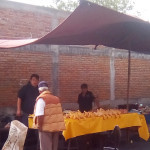




If you want chicken already cooked, you can go to a rosticería and get rotisserie chicken or pollos a la leña which are cooked over the open flame. You can buy whole chickens, pieces of chickens as part of a combo, sometimes with rice and mole or floppy french fries, or an order of pescuezos (chicken necks).


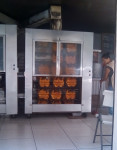
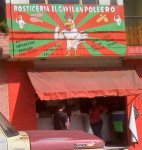
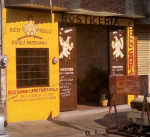

You can also get “American style” or “Kentucky” chicken in our area, which is fried (empanizada). Unbelievably the family packs are often served with coleslaw. UGH! Fortunately for our family, if you ask they will substitute the coleslaw, which NOBOBY likes, for an extra wing.
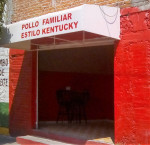

Where do you get your chicken?








